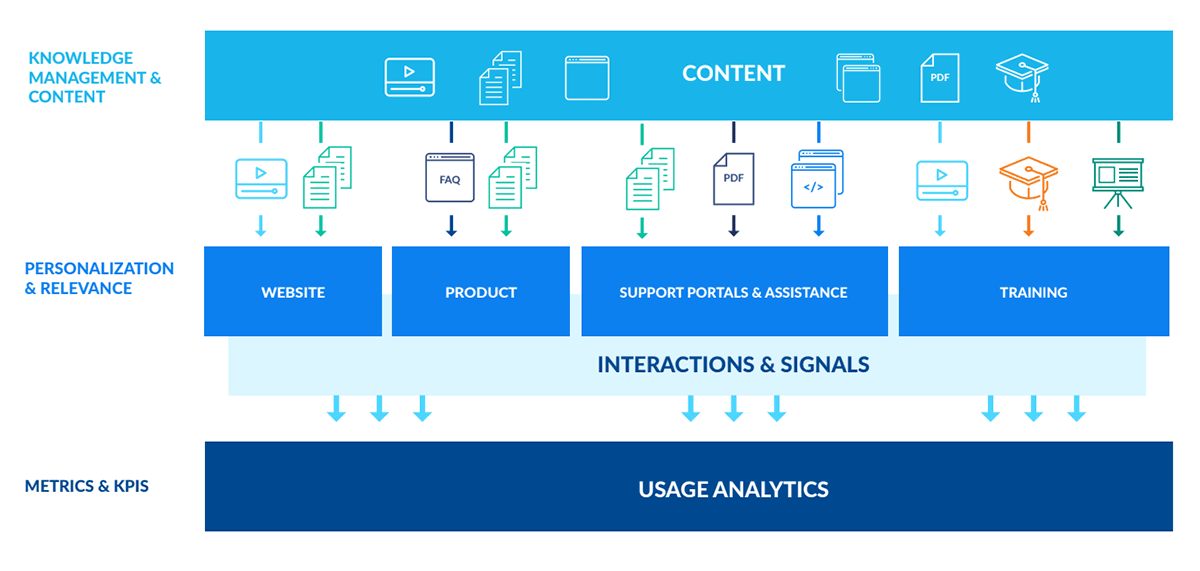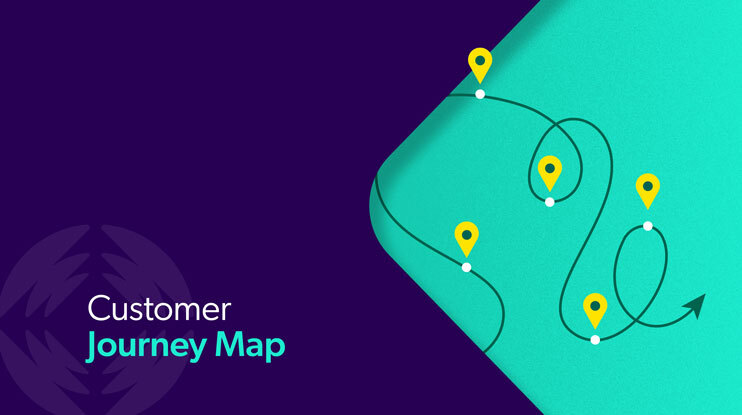How well do you understand your customer’s journey?
Our recent research uncovered that 93% of 4,000 consumers surveyed across two continents expect their online shopping experience to be at least equal to, if not better than, in-store. And companies like Amazon, Netflix, and Wayfair have set those expectations sky-high; how can others compete? Going beyond the price point by creating a compelling brand experience on a more personalized level.
How? One big step forward is enabling customers to self-service information needed to make an informed decision. This can be accomplished with unified search, bolstered by AI that can meet thousands of customers with a 1:1 experience.
But this starts by designing a search experience that proactively brings needed information from all corners of your business to where your customers are. This is where customer journey mapping comes in.
What is a Customer Journey Map?
Customer or user journey maps come in many different formats. At its core, journey maps are a visual representation of every experience and touchpoint your customers have with your brand. This is from first hearing about your product, to the ongoing relationship after the purchase.
Your map should be all-encompassing, informative, and detailed. But mostly, it empowers your merchandising, marketing, and customer service teams with the crucial insights into where you need to focus to optimize the journey for each of your key buyers’ personas. Think about your customers’ perspective: the information they need may lie scattered across multiple repositories – and they have no way to access it. Maybe, they don’t even know it exists.
Ideally, your journey map will map every single touchpoint and interaction your prospects and customers have with your brand, as well as their intent and motivation. By understanding where your customers land along their journey, you can match the right information to their needs at that time — and you can leverage AI to do the work for you.
However, don’t fool yourself into thinking that customer journey maps are perfect, linear, step-by-step sequences.
Brian Kilcourse, Managing Partner and Co-founder at Retail Systems Research, and Diane Burley, Head of Content at Coveo, break down where consumers are starting their shopping journey today. Tune in to Episode 2: The Next Generation of Retail commerce of our podcast, The Ecom Edge.
How Has Customer Journey Mapping Evolved?
Why bother creating a customer journey map? Simply put, customer behavior has changed. More and more, these visual tools are becoming completely necessary for CX professionals to navigate an increasingly complex and omnichannel customer experience. With the proliferation of tools and channels at customers’ disposal, understanding their journey and their motivations enables you to meet customer needs.
Today’s customer experience looks very different than it did before the rise of apps, context-aware technology, and search engines. Before mapping, the user journey meant seeing a linear progression of steps: from initial introduction, to product, to purchase, and re-engagement. Now, with the explosion in digital content and proliferation of channels, customer journeys are no longer linear.
Between customer communities, product documentation sites, social media, review sites, and more, there is too much content to consume before a purchase. This makes it impossible for a customer to follow a simple linear path — and the customer journey map allows you to evolve your understanding as well.
What Is The Science Behind Customer Journey Mapping?
Before we get into how to map your customer experience, we first need to understand the science behind the decisions we make as consumers. There are many different psychological studies that have gone into creating customer journey maps, but we’d like to highlight one in particular: the Fogg Behavior Model.
Behavior Scientist BJ Fogg founded the Persuasive Technology Lab at Stanford University and introduced the Fogg Behavior Model in 2007 to explain why humans change their behavior and how to create conditions to influence behavior change.
What is the Fogg Behavior Model?
In a nutshell, the Fogg Behavior Model postulates that behavior = motivation x ability x trigger. Essentially, when motivation, ability, and a trigger occur at the right moment, a change in behavior will occur.
There is a relationship here between the different variables. In graph form, it looks like this:
You want to keep your consumers in the upper right throughout their journey: high motivation for a task that’s easy to do with the appropriate trigger.
What Are The 3 Elements of the Fogg Behavior Model?
If you’re missing any of those elements (which is something a customer journey map can help you uncover), you’re potentially missing out on a conversion or valuable customer behavior insight.
It’s important to also keep in mind that, as marketers, we need to let customers be in the driver’s seat of their experience. Trying to tightly control the journey will not lead to the results you want to achieve. It’s a proactive yet organic experience you’re trying to create.
Meeting your customers at every single touch point is key to creating a relevant experience. Accurately predicting customer patterns will enable you to meet them where they are, whenever they are — scraping the need to rely on a huge staff support.
Let’s review the elements of the Fogg formula:
- Motivation: How much does your customer really want to make a purchase? Can you increase that amount? How attached are they with your offerings and brand? These answers explain the motivation of each buyer, and are key for every stage of the customer journey.
- Ability: This is where context comes in. How able are they to find the right content? Is the process difficult or require multiple steps? The more your prospects have to do to complete the desired action, the higher the motivation and trigger needs to be.
- Trigger: Why do they need to do this now? Anyone who has written an email for a limited time only promotion understands this one. Is it enough of a trigger to move them toward purchase? Keep in mind: the trigger has to be appropriate to the behavior. A customer’s mindset changes along your buyer journey. Your desired behavior may be for the prospect to meet with a salesperson, but that may not be appropriate if they have had no previous contact with your company. Instead, you may want to trigger them to read an educational blog post about a topic related to your product.
For instance, say you’re offering a commodity product at a standardized price. There’s not much motivation for your prospect to purchase it, especially from you.
However, if you increase their ability to make that purchase by reducing friction through answering all of their questions — for example, by surfacing the right discussion from your customer community, presenting a blog related to the topic, or pointing them to a video at the right moment — you will win that customer.
How Do You Gather Data For Customer Mapping?
It’s best to rely on data for your understanding of motivations and abilities. But, you need to analyze the right metrics to establish self-service success. These metrics will look different for every company, because you want to measure against yourself, and your audience, to understand what works.
Some of this can be collected via surveys, A/B testing and customer interviews. Marketers and CX professionals will also be able to understand quite a bit — just by looking through their own search analytics on users’ behavior throughout their website.
Looking at the most common page paths of the users who ended up leaving your website, without converting (for the pages that are designed to convert) will provide some clues as to where the content is not meeting your visitors’ expectations.
Similarly, you can use your search usage data to build your customer journey maps. By understanding your customers’ questions after viewing certain pages, before exiting your site without purchase, before purchasing, — really, at any stage along the buying journey — will empower you with crucial insights into where to optimize the customer experience. This way you can better match up the motivation, ability, and trigger.
Many companies are starting their customer journey map by focusing on their self-service portal first. With a defined audience (and one that is valuable), this can provide some “quick wins” before investing in a longer term project.
3 Best Practices for Making A Customer Journey Map
It’s time to throw out the playbook on creating customer journey maps. Remember, your user journey map should reflect the reality of what your customers want to experience, rather than your idealized definition of their journey.
To begin, use the data from your website, customer community and other channels to identify content and touchpoints in their journey. Then, identify where customers are bouncing to other websites and failing to convert.
Now optimize the website pages as much as possible so customers and prospects are getting the information they need from each channel and content to drive self-service success. Your role as a marketing and website team is to enable your customers to explore and discover, not direct them to your next offer.
More traditional marketing campaigns, based on the assumption that customers and prospects need to be given marching orders, are no longer going to cut it. Customers want to find answers on their own to enable a better customer experience. Your approach to customer journey mapping needs to reflect this new reality.
In truth, you may end up with more questions than answers when you begin your customer journey map project – and that’s OK. This gives you a starting point to highlight where your data analysis gaps are and can be helpful when you evaluate your marketing and website technology stack.
#1 Identify your key personas.
How To Use Quantitative Data For Customer Journey Mapping
Use your existing customer data to understand who your different segments of buyers are, what they’re buying, and why. Focus first on what quantitative research can tell you, from your customer surveys, demographic data to marketing automation information.
Even your internal site search analytics will provide important clues for customer expectation when they land on your website with different products. What questions do they have? What content is most helpful before, during, and after a purchase?
How To Use Qualitative Data For Customer Journey Mapping
Then, start looking at your qualitative data from customer surveys and representative focus groups. Conducting user tests, gathering panels, or even interviewing users is not always possible, but some tools can give you valuable qualitative data.
For a website or app, you can use a session recording software such as Lucky Orange or Inspectlet to give you insight into how your users interact with your digital properties. With that, you can highlight recurring pain points they have with your site or conversion funnel.
Try to merge your qualitative understanding of your buyer persona with your quantitative data.
#2 Use data to match content with customer intent and behavior.
What Do Customer Journey Maps Look Like?
Just search for “customer journey map images,” and you’ll see a whole slew of different versions of what customer journey maps look like. These examples, while interesting, provide a generic version, but you need to make your customer journey map reflect the reality of your customers’ experiences and interactions.
Customer journey maps come in all shapes.
Journey map example:

How To Create Your Own Customer Journey Map Framework
Try to build your own user journey map with the data you have, using the existing resources and images you find online as inspiration, rather than gospel, for how you are building your own. Most customer journey maps group content like this:
- Awareness. Your prospect first becomes “aware” of the problem they face. They are looking for solutions, and come across your product. They may see some tweets, emails or references from friends on the issue.
- Comparison. Especially for larger purchases, prospects will start to research their options. This is where the content they consume will be pulled from many different sources. Expect them to look at your customer community, review sites (including video reviews on YouTube), websites, product documentation sites, social media channels and more when researching the purchase.
- Purchase. With the right information, they’ll be ready to make the purchase. It’s important to keep in mind that a difficult purchase process or a key, but difficult-to-find, piece of content often contributes to delay at this stage.
- Repurchase/engagement. Customer retention is the goal here. Make sure that your customers are able to self-serve their answers quickly and easily, as well as understand related products that may be of interest.
As you map out the stages for each key persona, you should also begin mapping their motivations and abilities at each stage — à la the Fogg Behavior Model, and how they align with your current strategy.
What are they hoping to achieve? How motivated are they at each stage? What is their ability? What will trigger them? Try to keep these, as much as possible, grounded in the data that you have.
At that stage, we’d recommend using whiteboards, sticky notes, large paper sheets or even online whiteboarding tools such as Miro. The goal is to make sure you have all the room you need to add, write, or dribble ideas and draw connection lines.
#3 Identify the obstacles in the way of your customers’ journey.
This is where user experience research, click maps and other design-focused research will come in. Your goal is to identify the blockers and their solutions to enable your customers to move to the stage that is most appropriate for them. Here are a few common blockers (and our suggested solutions):
- “I didn’t find the answers I needed.” Customers today expect the information they need to be right at their fingertips; this is where a powerful site search solution comes in. They are most likely using the search box to find these answers, and a generic search experience without tailored recommendation will be too difficult for them to overcome.
- “I had to start over with my questions and didn’t have the time.” Stop treating your channel experiences as separate entities. In today’s world, you’re just creating more fragments in your user experience. Weave together a unified search experience with a single content index across all platforms. Any-and-all content needs to be quickly accessible no matter where it resides – especially when it can answer a question. Your customers have a lot of content competing for their attention; using mapping to make it easy to find what they need on your site, means they’ll come back again, and again.
- “I want to hear from a customer in a similar situation.” With the advent of social media, we’re social beings. Who shops online without checking the star count and reading reviews? This is a great case for building your social proof. Whether it’s in a customer community and providing customer feedback in every experience, or making case studies and customer satisfaction a central piece of your strategy. Product badging is an easy revenue-driving strategy that can be built to enhance your customers’ self-service experience, using adaptive ecommerce AI.
Pro tip: It is better to have no data at all than bad data. If you think your team may be going off assumptions and gut feelings, redirect your project as soon as possible. There’s nothing wrong with “guessing” at your personas, but only if you’re able to check those guesses later with data.
Defining your customer journey is a lot of effort, but it’s worth it especially if it exposes areas you may be overlooking as you try to optimize your online store. Now, more than ever, your customers are in control of their own journey and it’s down to your digital transformation to better customer experience. Every digital touch point counts. The ease of search and accessing information, and self-service will shape your customer success. Now is the time for a digital transformation with self-service to predict customer needs, and build that customer loyalty.
One easy place to start is with the self-service portal. You will have more data from your customers, including purchase history, demographic data, and more, that you can use to understand how they engage with you when they need to find answers about the product or solution they purchased.
Dig Deeper
Understanding your customer journey and outlining it with a journey map is just step one of providing a great site experience and relevant content discovery. Learn how you can take the next step with intelligent site search.


